How many times have you heard phrases like game changer, revolutionary and neva ben dun befo in regards to firearms? I’ve probably been guilty of it, and sometimes, you just get excited about a gun and specific features. Sometimes, those terms are used a little too lightly. Still, when High Standard introduced the Model 10 in 1967, they could have fairly described the gun as a revolutionary weapon, as a game changer and it was certainly a first for American shotguns.
The Bullpup That Had Bite
I imagine the High Standard Model 10 got a lot of attention when it hit the streets in 1967. High Standard built the Model 10 as a gas-operated, semi-auto, 12-gauge shotgun that used a bullpup format. To establish a perspective, guns like the Steyr AUG were still a decade away from being produced. Bullpups, up to this point, had been largely experimental weapons like the Thorneycroft Carbine and the Faucon Balanced rifle. The Nazis used the Czech-made PzB M.SS.41 anti-tank rifles for a bit in World War II, but the concept was still uncommon.
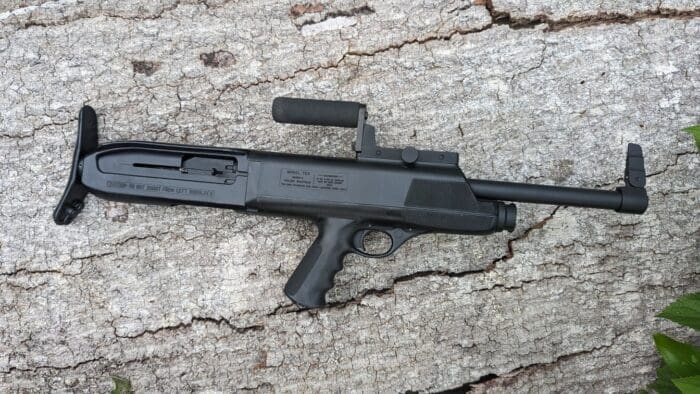
The idea behind the Model came from a police sergeant named Alfred Crouch. He envisioned an incredibly compact entry shotgun that would serve with special police units. Crouch began working to create a bullpup shotgun using a Remington semi-auto shotgun. His design worked well enough that High Standard purchased the idea.
High Standard already had a successful semi-auto shotgun design in the form of the C1200 Supermatic. The design worked, so they used it as their basis for the Model 10. To create the bullpup layout, they encased the receiver, barrel and magazine tube with a three-piece polymer shell. A trigger linkage and a rotating stock were added to finish the weapon.
A Tale of Two Model 10s
High Standard built two models. The first was the model 10A, which featured an integrated flashlight and carry handle. This was a very early attempt to add a weapon-mounted light to a gun without hose clamps or duct tape. High Standard took some lessons learned for the A and produced the Model 10B.

The Model 10B removed the integrated light but provided a mounting system for a Kel-lite-branded flashlight with a specialized mount. High Standard added a left-side nonreciprocating charging handle and a carry handle added. The Model 10B used a flip-up front sight and a simple notch rear sight.
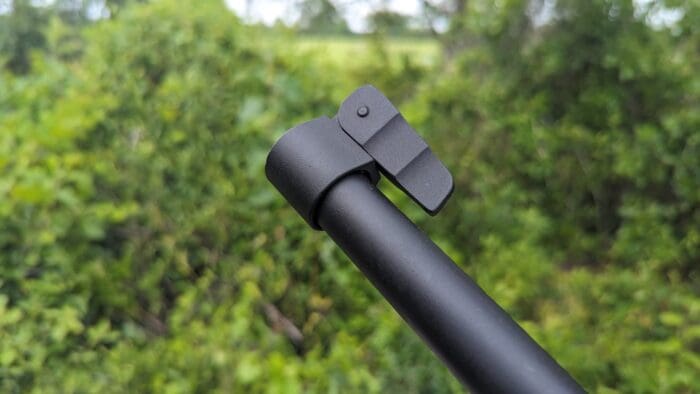
These guns held four rounds of 2 3/4-inch 12 gauge and could only chamber 2 3/4-inch rounds. A magazine extension brought the capacity up to six rounds. Both had 18-inch barrels and an overall length of just over 26 inches. Any shorter, and they’d be NFA weapons due to their overall length. As you can likely tell, mine is a Model 10B.
Diving Into the Model 10
The gun has a simple push button safety in front of the trigger. It’s a crossbolt like most other shotguns. The B model has dual charging handles. We get one on the action itself and the aforementioned left-side charging handle. The bolt locks open when the last round is fired, and a small button closes the bolt when pressed.
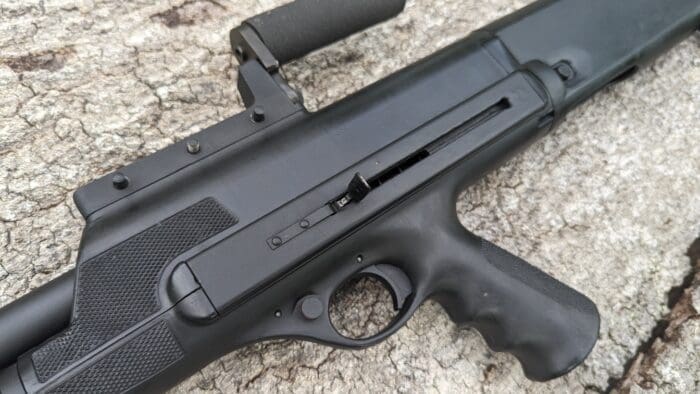
There are some neat ideas with the Model 10, but they aren’t all winners. In fact, some are downright confusing.
The bolt release button also unlocks the loading gate. I have no idea why anyone uses a locking loading gate. It’s the second semi-auto shotgun I know of that requires you to press a button to load the tube.
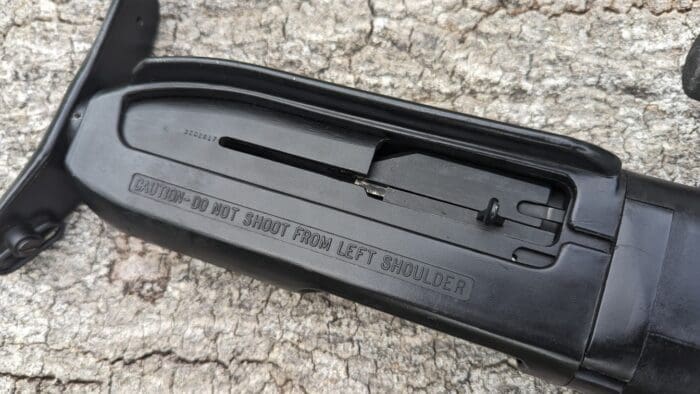
This means you aren’t topping the gun off in a fight, and to reload, you have to flip the gun over and press the button, hold the button and thread rounds into the tube. If you release the button and the gate closes, it stays locked until you unload the gun.
It’s mucho stupido. The carry handle doesn’t lock in any position, so like a fish, it flops around. At the rear end of the gun, we have a stock, or just really a butt plate that swivels. As far as I understand, the swiveling butt plate allows you to brace the gun against your arm for hip firing. But, like, why? It’s another annoyance and can also unscrew itself and fall off.

You can’t fire the gun from your left shoulder. You won’t just get a shell in the face, but the right-side charging handle will hit you harder than when your mom found out you uttered a curse word in Sunday school. High Standard made some questionable decisions.
To the Range With the Model 10
The Model 10 saw some limited success. Some police agencies adopted the gun, but not many. The only one I confirm is Las Vegas, and that’s because I found an LVPD-marked gun listed on an auction website. Apparently, both the Mexican and Argentinian military forces adopted the gun. It didn’t seem to last long in service with anyone due to reliability issues.
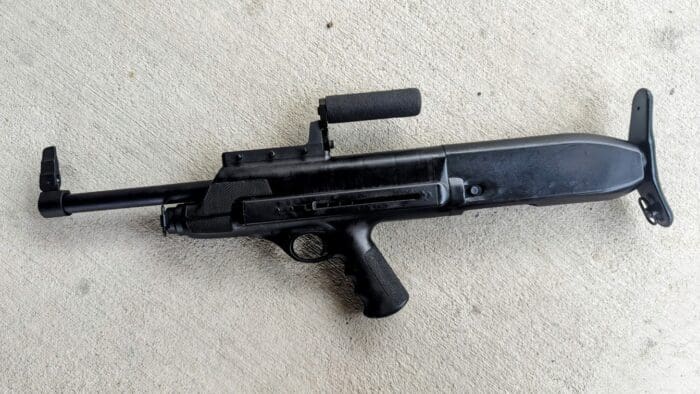
The gun says to use magnum and high-brass loads only. I grabbed some heavy-duty Fiocchi high-brass birdshot to test the gun prior to purchase, and it chucked and shucked them like nothing. At home, I tried a good mix of bird and buckshot, and it likes the high-velocity loads and, in general, premium loads.
In testing, 99.99% of any sub-1,300 fps load had spotty reliability. The only exceptions were the reduced recoil FliteControl rounds and Federal Reduced Recoil Tactical Slugs. Those are premium loads, and for some reason, they made a difference.

With the sub-1,300 fps stuff, the Model 10’s reliability wasn’t all that bad. It’s not good enough to take to a fight, but I could make it through an entire tube of Wally World birdshot at least 50% of the time.
It’s also worth noting that every 1,300 fps load didn’t always reliably run; I still got the occasional failure to eject, but they were fairly limited. Admittedly, it’s not up to fighting gun standards, but I expected it to be a lot worse. Maybe I just have a good one?
Everything Else
The sights kind of suck. The small rear notch isn’t great for quickly finding the front sight. The sights are also pretty high over the bore, which isn’t great for a dedicated close-quarters weapon. You run into those pesky height-over-bore issues quickly with the Model 10. There is no way to adjust the sights, and it’s not a big deal with buckshot, but it makes slugs guesswork. Alfred Crouch designed the gun for entry work, so slugs weren’t considered.
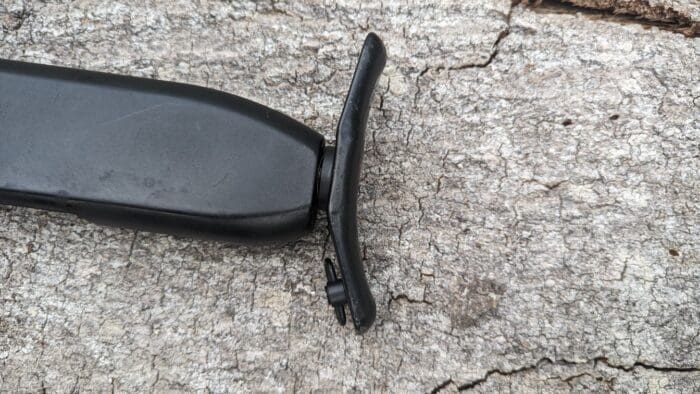
The recoil is abusive. It hits the shoulder hard and has no give. You don’t have much room on the front of the gun to use the push/pull technique to help. There isn’t much room between the action and you, so you get all of that recoil without as much as the sniff of a recoil pad.
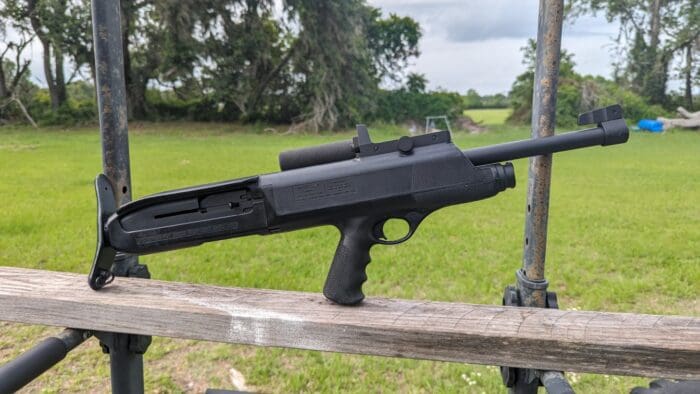
Pair this with using full-powered magnum loads, and your shoulders might call Child Protective Services on you. Even the reduced-recoil stuff was worse than any semi-auto shotgun I’ve handled. Recoil typically slows you down, but since this is a bullpup shotgun that weighs 10 pounds, there isn’t much muzzle flip. You can shoot the weapon very quickly and surprisingly effectively.
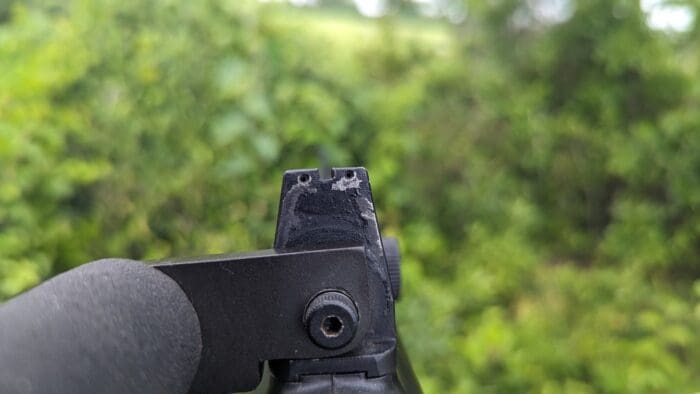
The Model 10 has its problems, for sure, but it’s still a really fun gun. It’s interesting to see such an early bullpup design. Ultimately, I think bullpups and semi-auto shotguns can work well together. There just aren’t a ton of well-made bullpup semi-auto shotguns out there. I’d take the Model 10 over most of the Turkish junk bullpups out there. Maybe some enterprising gun manufacturer will make one that works well one day.
Need Ammo? Check out Ammo To Go, the ammunition retail sponsor of TTAG gun reviews and simply a cool online place to fulfill all your ammo needs.

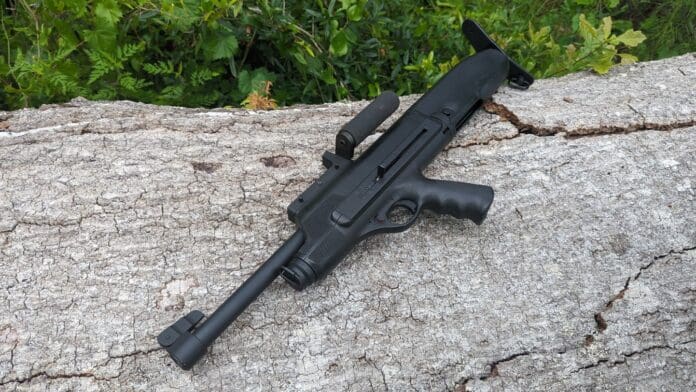



I remember this gun from the day. Never had a desire to use one. Ugly as home made sin.
I thought the same about the spas 12. Shotgun that was butt ugly and with a big ass fish hook on the stock. Just weird.
I came in thinking neat but would need to move to even consider it. But according to the specs the non extended capacity version may actually be NY legal without any permits. Weird new thing learned for the day.
Eargersplittenloudenboomer
For when you really want to be an asshole at the smallbore range.
“Eargersplittenloudenboomer”
That’s Amish for “Whoa Nelly!”
Ahhtahhey!! Ahhtahey!!
and then your horse goes over the cliff
The Model 10’s swivel buttstock rotates because the weapon was designed not only to be fired from the hip one-handed but, also from an open car window one-handed by either the driver or passenger. You grasp the pistol grip in the firing hand and place the buttstock in either the crease of your elbow as shown in the photo or along the arm depending on your arm length, then place the weapon outside the window, you do not need to lean your head outside the window to fire, just don’t shoot your mirror off.
The Kel-Lites for this shotgun are extremely difficult to come by. Choate at one time made the magazine extensions but, no longer. Milt Sparks made a leather “Side Saddle” spare ammunition carrier, I purchased the last two of those over 20 years ago
“The Model 10’s swivel buttstock rotates because the weapon was designed not only to be fired from the hip one-handed but, also from an open car window one-handed by either the driver or passenger.”
Perfect for when that rare drive-by opportunity suddenly presents itself to you…
Travis, you might like the IWI TS12B. I have one. Put the Manticore muzzle brake and butt pad on it to reduce recoil. Fine shooter and you can ghost load it for 17 on board. It is heavy with a full load, as you might expect.
I’ve been silent for awhile, but this is harmless. My acquaintance with the High Standard Model 10 began when I was in junior high 4 H. Every year we went to the regional fair. The local sheriff’s department always had a display. It included a live marijuana plant, photos of crime scenes (nothing graphic) and firearms. The star was a High Standard Model 10. Saw it several years in a row. Simultaneously I was reading Mel Tappin. He thought that shotgun was the do all, end all. I later learned, not so much.
Harmless? That aside lot cooler than 4h outside of Philadelphia and to your point below also had good experiences with Mossberg 500/590 or a Maverick 88 if you are really strapped for cash. Very much prefer the Remington 870 overall.
“I’ve been silent for awhile, but this is harmless.”
Glad to hear it wasn’t permanent, wondering where you’ve been…
If you gotta have a defensive shotgun of some kind, buy a Remington 870, or a Benelli of some description.
Auto-loaders are far more comfortable to shoot, pumps have the edge in reliability.
When you absolutely, positively need to solve a pressing problem…
… oh, and valve stems, I almost forgot about the valve stems
Back in the day when law enforcement agencies had less voluminous policy manuals, the novel at the time big ole mounted flashlight on the High Standard 10A resulted in a groundbreaking written policies either forbidding the routine substitution of the 10A for a flashlight or the outright ban of the 10A for duty use because somewhere some knucklehead did. The first High Standard 10A I ever saw was a used gun at Wald Police Supply in downtown Dallas in 80-81, even though I thought it was cutting edge cool, my $898mo small town PD salary at the time left me too poor to afford more than 1 duty weapon.
Rifle scope or do sight, which one is more suitable for AR15 to hunt?
https://www.cvlife.com/blogs/news/red-dot-sights-vs-rifle-scope-what-s-the-best-for-ar-16
If I choose the scope, how about this one?
https://www.cvlife.com/products/cvlife-1-6×24-lpvo-scope-with-cantilever-mount
Comments are closed.